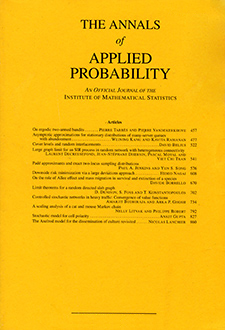Abstract
We consider an interacting particle system on trees known as the frog model: initially, a single active particle begins at the root and i.i.d. many inactive particles are placed at each nonroot vertex. Active particles perform discrete time simple random walk and activate the inactive particles they encounter. We show that for Galton–Watson trees with offspring distributions Z satisfying and for some , there is a critical value separating recurrent and transient regimes for almost surely every tree, thereby answering a question of Hoffman–Johnson–Junge. In addition, we also establish that this critical parameter depends on the entire offspring distribution, not just the maximum value of Z, answering another question of Hoffman–Johnson–Junge and showing that the frog model and contact process behave differently on Galton–Watson trees.
Funding Statement
First-named author supported in part by NSF Grants DMS-2137623 and DMS-2246624.
Second-named author supported by a Zuckerman STEM Postdoctoral Fellowship, as well as by ISF grant 1207/15, and ERC starting grant 676970 RANDGEOM.
Acknowledgments
The authors are grateful to the anonymous referees for their numerous comments which helped streamline and improve the draft.
Citation
Marcus Michelen. Josh Rosenberg. "The frog model on Galton–Watson trees." Ann. Appl. Probab. 34 (4) 3911 - 3942, August 2024. https://doi.org/10.1214/24-AAP2054
Information





